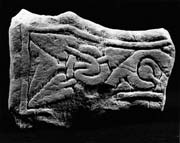Select a site alphabetically from the choices shown in the box below. Alternatively, browse sculptural examples using the Forward/Back buttons.
Chapters for this volume, along with copies of original in-text images, are available here.
Object type: Cross-arm [1]
Measurements: H. 15.8 cm (6.25 in); W. 22.2 cm (8.75 in); D. 7.6 cm (3 in)
Stone type: Fine- to medium-grained, very pale brown (10YR 7/4) sandstone; deltaic channel sandstone, Ravenscar Formation, Aalenian, Middle Jurassic; possibly from Aislaby, near Whitby (see Fig. 5).
Plate numbers in printed volume: 38-43
Corpus volume reference: Vol 3 p. 59-60
(There may be more views or larger images available for this item. Click on the thumbnail image to view.)
A (broad): The double edge moulding runs round the cusped perimeter of the arm, which is type D10. The outer one is cabled and slim; the inner, plain, slightly modelled, and very slim. The panel contains the termination of a broad-leaved plant-scroll. Each scroll has a spear-shaped leaf passing out of it at an angle, their edges serrated to give a faint fern-like impression. There is a rudimentary ridged node with a pair of incised lines across it and the leaf shoot at the narrowest part swells into a circle to fill the centre of the scroll. The termination consists of a bilobate, cupped blossom, flanked by broad pointed leaves with serrated edges which fill the corners. The design has horror vacui.
B (inner end): Broken, but there are remains of a dowel hole for fixing the arm to the stem.
C (broad): The double edge moulding is identical with the one on face A. The panel is densely filled with closely woven six-strand plain plait with included U-bend terminals which fit tightly into the corners of the panel. The strands are broad, plain, and fairly flat. The pattern is expanded to accommodate it to the shape of the arm.
D (outer end): A secondary, roughly incised type A1 cross has been scratched on the plainly tooled surface.
E and F (long sides): Plain, except for cable moulding on the edges.
The form of the cusped cross-arm has many Anglian parallels; for example, Lastingham 3 (Ill. 587). The dowel fixing might have been a repair since the size of the cross-head might allow for its originally having been monolithic.
The dense plain plait and the horror vacui of the plant-scroll point to a late Anglian date. The picked technique and outward looping of both motifs also suggest inferior workmanship. This poor quality carving is also apparent in the faulty accommodation of the plain plait to the panel containing it: There was certainly no gridding to control the symmetry, and the junctions of the crossing are of varying thickness and sometimes misaligned. The clumsily twisted stalks of the plant on face A are equally inexpert, but may be a copy of the late Anglian mannerism of a shaft found in the river at Ilkley, West Riding (Collingwood 1915, 197, fig. m). Perhaps by the ninth century Yorkshire expressions of plant-scroll were growing less organized.
A further West Riding parallel lies in a cross-arm fragment from Dewsbury (Collingwood 1915, fig. i on 166). As well as the flat cutting style, this piece shares no. 10's fern-like pointed leaf, a feature Collingwood regarded as late Anglian.
1. All the pieces from the Minster were discovered as a result of the excavations of 1966-71 by H. Ramm and D. Phillips. They are to be published as a handlist, together with a critical essay, in the forthcoming Royal Commission volume on the excavations. That publication will provide the finer detail of their archaeological contexts, both in a table, and in a description of the excavation of the south transept cemetery.
The following are general references to the stones: Wilson 1978, 142; Hall 1980b, 7, 21; Lang 1988b, 8, 12; Lang 1989, 5.



